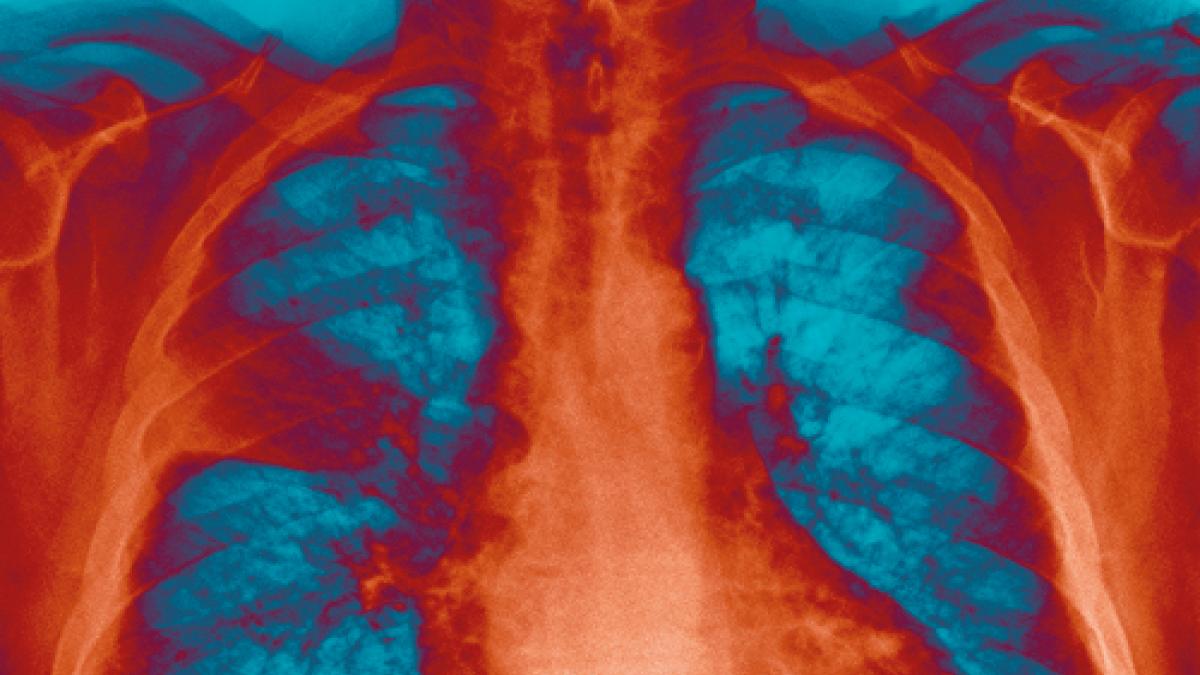Pneumonia affects up to one person in 100 every year in the UK. Laura Breach, public relations officer for the ACPRC, outlines the physiotherapist’s role in treating it.

Pneumonia is an infection in the tissues of the lungs. It causes fluids and inflammatory mediators to proliferate in the lung tissue and air sacs. This stops the lungs from working properly.
Pneumonia is a primary cause of mortality and emergency hospital admissions in the UK. Every year in the UK, from 0.5-1 per cent of adults are diagnosed with community-acquired pneumonia. Up to 10 per cent of these patients are subsequently admitted to hospital, where the mortality rate is up to 14 per cent. If a patient is admitted to intensive care with pneumonia, this mortality rate increases to 30 per cent. Older patients are particularly vulnerable; people over 84 years make up over half of the deaths from pneumonia.
In secondary care, 1.5 per cent of the patients in hospital in England have a hospital-acquired respiratory infection at any given time. This is estimated to increase length of stay by up to eight days and can increase mortality rate from 30 to 70 per cent, according to the 2016 NICE quality standards. See Pneumonia in adults here.
In secondary care, the CURB65, a modified CRB65 which also assesses blood urea levels, is used.
What is the physiotherapy role in treatment?
Physiotherapists play an important role in helping patients with pneumonia to recover. We can provide holistic assessments and specialist skills, such as;
- admission avoidance – from 22 to 42 per cent of patients diagnosed with community-acquired pneumonia (CAP) are admitted to hospital (NICE 2016);
- management of respiratory failure;
- management of airway secretions (airway clearance techniques, positioning);
- reduction of increased work of breathing (positioning, breathing techniques);
- management of co-morbidities (chronic obstructive pulmonary disease, neuromuscular disease, cerebral vascular accident);
- recovery from illness, including early mobility, exercise and safe discharge.
What do the NICE quality standards mean for physiotherapists?
Statement 1. Adults have a mortality risk assessment using the CRB65 score when they are diagnosed with CAP in primary care.
- CRB65 assessment tells us how likely a patient is to become seriously unwell, or die, from their pneumonia. It helps professionals to make the best decisions about whether a patient should be admitted to hospital, or treated at home. Physiotherapists can often be the first contact for patients in the community with respiratory infections, and may even be in a position to make decisions about how and where the patient is treated. It is important that we understand, and use, the CRB65 where appropriate to ensure high-risk patients receive the necessary level of care, while preventing unnecessary admissions for patients who are a lower risk
Statement 2. Adults with low-severity CAP are prescribed a five-day course of a single antibiotic.
- antimicrobial stewardship is a pressing priority in the medical world. It relates to prescribers ensuring they do not give antibiotic treatment unnecessarily, or give an unnecessarily long course;
- pneumonia usually starts with a bacterial infection, so a mild case should respond to a five-day course of antibiotics. If a patient’s symptoms persist beyond this, they should have further investigations, or be admitted to hospital;
Statement 3. Adults with suspected CAP in hospital have a chest X-ray and receive a diagnosis within four hours of presentation.
- a chest X-ray is an important tool in ruling out conditions that could present similar symptoms, such as pulmonary oedema or problems with the heart;
- once the chest X-ray has been performed, the patients should receive a diagnosis as soon as possible to ensure there is no delay in receiving treatment;
Statement 4. Adults have a mortality risk assessment using the CURB65 score when diagnosed with CAP in hospital.
- in order to promote equity in care and improved outcomes, it is important that the same tool is used to assess the severity of pneumonia in different NHS trusts,and in both primary and secondary care;
- the CURB-65 helps clinicians to make the right choices about how and where the patient is cared for, based on the severity of their pneumonia and their risk of deterioration or death.
Statement 5. Adults with CAP who are admitted to hospital start antibiotic therapy within four hours of presentation.
- evidence tells us that patients who are put on antibiotics quickly have a better chance of recovery, particularly if the treatment is started within four hours;
- if you think your patient may have pneumonia you should speak to the medical team as soon as possible. fl
Laura Breach is public relations officer, ACPRC
For more information see the
How is pneumonia diagnosed?
- Chest X-ray
- CRB65 or CURB65
- Presenting symptoms indicative of lower respiratory tract infection (LRTI), such as persistent productive cough, shortness of breath and a raised temperature.
What is CRB65?
- CRB65 score for mortality risk assessment in primary care 1;
- CRB65 score is calculated by giving one point for each of the following prognostic features;
- confusion (abbreviated Mental Test score of eight or fewer, or new disorientation in person, place or time)2 raised respiratory rate (30 breaths a minute or more);
- low blood pressure (diastolic 60 mmHg or less, or systolic less than 90 mmHg);
- aged 65 years or older.
Patients are stratified for risk of death as follows:
- 0: low risk (less than 1 per cent mortality risk).
- 1 or 2: intermediate risk (1-10 per cent mortality risk).
- 3 or 4: high risk (more than 10 per cent mortality risk).
References
1 Lim WS, van der Eerden MM, Laing R et al. (2003) Defining community acquired pneumonia severity on presentation to hospital: an international derivation and validation study. Thorax 58: 377–82.
2 For guidance on delirium, see the NICE guidelines here. For additional material, including a commentary and references, are available in the online version of this article.
Author
Laura BreachNumber of subscribers: 1
